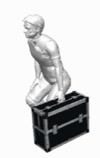Lifting is a regular part of our lives whether it is getting the groceries into the car after a long shopping trip or handling boxes of supplies at work. It is important that we lift safely to prevent sprains or strains that can impact both your work and home life.
Preventing sprains and strains involves reducing risks. When it comes to lifting, risks for sprains or strains involve high forces, awkward postures, repetition, and in some instances, static postures.
Safe lifting requires good body mechanics and limiting the weight of objects whenever possible, which may involve getting help when loads are too heavy or bulky. A load can be limited by not overfilling boxes, bags, or bins or by opening the box and offloading individual items instead of moving the full box. Repetition can be limited by practicing task variance; this involves performing alternate tasks between bouts of lifting so that lifting is less frequent overall. It may also require more than one worker perform the lifting to reduce the overall exposure to a single worker.
When lifting, use the ABC’s as outlined below to ensure that you are using good body mechanics:
“A” stands for Assess the Load:
- Test the weight and balance of the load by lifting a corner or reading a packing label
- Consider where the load is located; on the floor, at waist level, or over the head? The lower or higher the load relative to your waist the greater the strain on the body.
- Determine if you need help
“B” stands for Be Prepared:
- Wear appropriate footwear (non-slip, closed back, and possibly steel-toed)
- Remove any trip hazards
- Get a good grip on the load
“C” stands for Complete the Lift:


- stand with a wide base to use the power position,
- bend the hips and knees while keeping the spine aligned
- face the object directly to avoid twisting,
- keep the object close to the body,
- tighten the stomach muscles while lifting, and
- lift slowly with control
Also, consider if alternate lifting techniques would be appropriate like the Golfer’s Lift. A golfer’s lift can be used to lift an item that weighs less than 5 pounds and can be lifted with one hand. While supporting the upper body on a stable surface, bend at the waist and slightly bend
 the supporting leg. As you are bending forward, the other leg swings up behind you. Again, make sure it
the supporting leg. As you are bending forward, the other leg swings up behind you. Again, make sure it is only used for light objects weighing less than 5 pounds and that can be easily grasped in one hand.
is only used for light objects weighing less than 5 pounds and that can be easily grasped in one hand.

 For bulky or unstable items, consider using a Tripod Lift to control the load. To do a tripod lift get down low, pull the object close to the body and use the powerful muscles of the legs to lift the load.
For bulky or unstable items, consider using a Tripod Lift to control the load. To do a tripod lift get down low, pull the object close to the body and use the powerful muscles of the legs to lift the load.
Lastly, consider the Support Lift. Use the support lift when lifting and carrying an
 object in one hand, bend at the waist and bend the knees, support the upper body with one hand on the thigh, lift the object next to the body while maintaining the s-shaped curve in the spine.
object in one hand, bend at the waist and bend the knees, support the upper body with one hand on the thigh, lift the object next to the body while maintaining the s-shaped curve in the spine.
Using safe lifting techniques and the appropriate lift for the situation will help keep you safe so that you can live your life to the fullest; lift safe, live safe! If you have any questions about this blog feel free to contact us at 780 436 0024 or info@ewiworks.com

